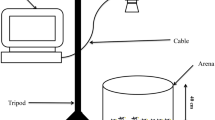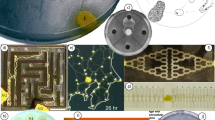Summary
Feeding blue tits (Parus caeruleus) increase their scanning rates as predation risk increases. However scan durations remain constant. As risk increases the frequency distribution of inter-scan intervals shifts from a regular (rectangular) to a random (exponential) distribution with a 0.5 s constraint on the minimum inter-scan interval.
Cine analysis reveals that this 0.5 s constraint represents the minimum time needed to extract a piece of peanut from a feeder (the ‘handling time constraint’). Manipulating handling times by grinding peanuts to smaller sizes allows tits to adopt random scanning patterns.
Similar content being viewed by others
References
Barnard CJ (1980) Flock feeding and time budgets in the house sparrow (Passer domesticus). Anim Behav 28:295–309
Bertram BCR (1980) Vigilance and group size in ostriches. Anim Behav 28:278–286
Caraco T (1979a) Time budgeting and group size: a theory. Ecology 60:618–627
Caraco T (1979b) Time budgeting and group size: a test of theory. Ecology 60:611–617
Caraco T (1982) Flock size and the organisation of behavioural sequences in juncos. Condor 84:101–105
Caraco T, Martindale S, Pulliam HR (1980) Avian flocking in the presence of a predator. Nature 285:400–401
Cowie RJ, Houston AI, Kacelnik A, Krebs JR, Tarpy R (1981) Cited in McFarland DJ, Houston AI Quantitative ethology: the state space approach. Pitman, London
Dobson A (1981) Mortality rates of British birds. D Phil thesis, Oxford University
Elcavage P, Caraco T (1983) Vigilance behaviour in house sparrow flocks. Anim Behav 31:303–304
Elgar MA, Catterall CP (1981) Flocking and predator surveillance in house sparrows: test of a hypothesis. Anim Behav 29:868–872
Hays WL (1973) Statistics for the social sciences. Holt, Rinehart & Winston, London
Lazarus J (1979) The early warning function of flocking in birds: an experimental study with captive quelea. Anim Behav 27:855–865
Leudrem DW (1980) Vigilance of a nest building female blue tit (Parus caeruleus). Z Tierpsychol 54:279–284
Lendrem DW (1982) Vigilance in birds. D Phil thesis, Oxford University
Leyhausen P (1973) Verhaltensstudien an Katzen. Z Tierpsychol (Beiheft) 2:1–232
McVean A, Haddesley P (1980) Vigilance schedules among house sparrows (Passer domesticus). Ibis 122:533–536
Norberg UM (1979) Morphology of the wings, legs and tail of three coniferous tits, the goldcrest, and the treecreeper in relation to locomotor pattern and feeding station. Philos Trans Soc Lond [Biol] 287:131–165
Partridge L (1976) Some aspects of the morphology of blue tits (Parus caeruleus) and coal tits (Parus ater) in relation to their behaviour. J Zool (Lond) 179:121–133
Partridge L (1979) Differences in behaviour between blue and coal tits reared under identical conditions. Anim Behav 27:120–125
Perrins CM (1979) British tits. Collins, London
Schaller GB (1972) The Serengeti lion. Chicago University Press, Chicago
Siegel S (1956) Non-parametric statistics for the behavioural sciences. McGraw-Hill, New York
Snedecor GW, Cochran WG (1967) Statistical methods. Iowa State University Press, Ames
Stokes AW (1962) The comparative ethology of Great, Blue, Marsh and Coal tits at a winter feeding station. Behaviour 19:208–218
Author information
Authors and Affiliations
Rights and permissions
About this article
Cite this article
Lendrem, D.W. Predation risk and vigilance in the blue tit (Parus caeruleus). Behav Ecol Sociobiol 14, 9–13 (1983). https://doi.org/10.1007/BF00366650
Received:
Accepted:
Issue Date:
DOI: https://doi.org/10.1007/BF00366650




